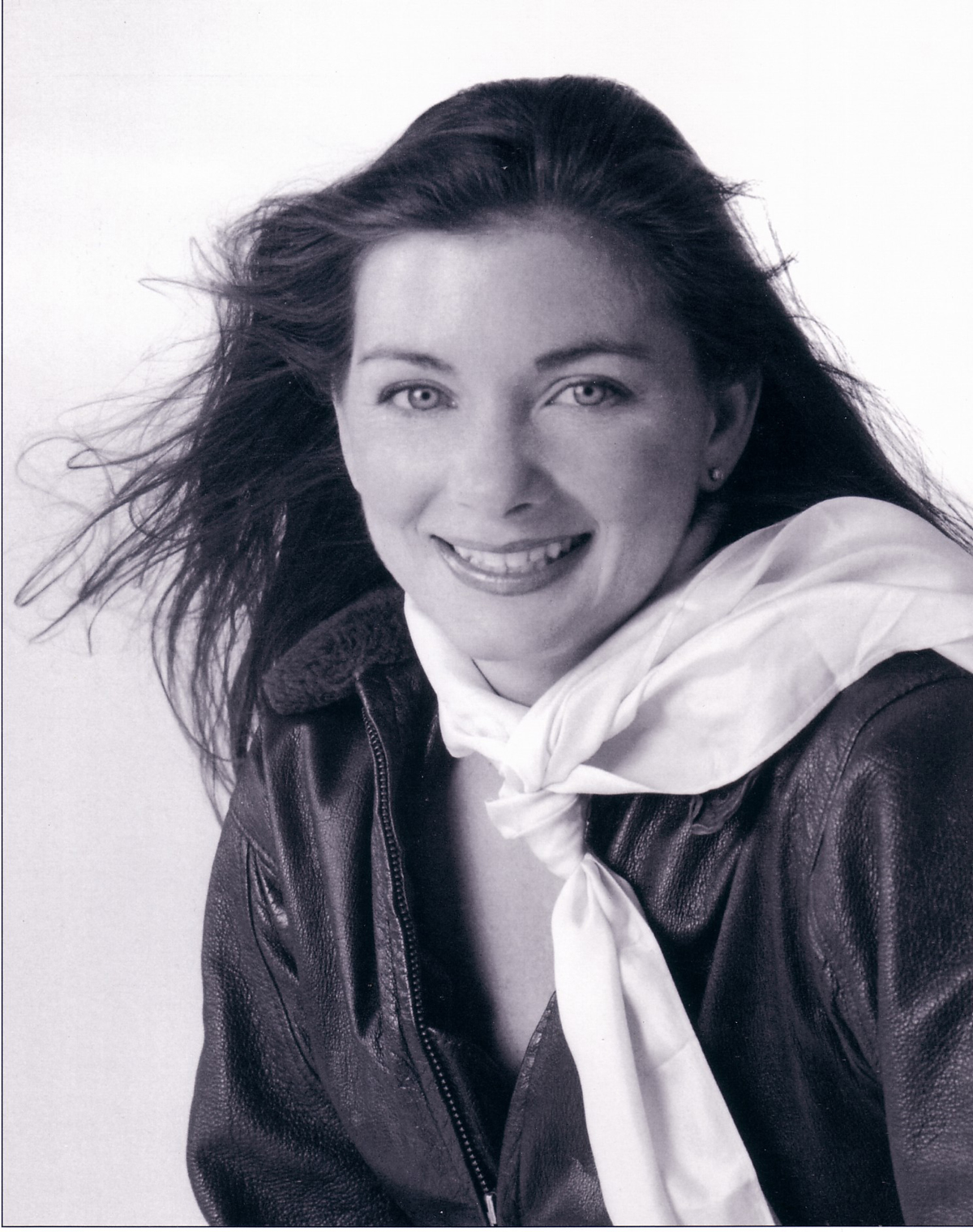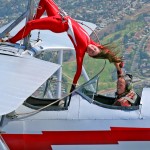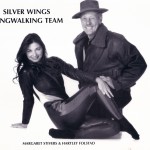
With more than 1,000 wing walks under her belt, Margaret “Margi” Stivers is one of the most specialized stunt performers in the world.
By Clayton Moore
It would be hard to find anyone who has experienced the sheer joy of flight as viscerally as Margaret “Margi” Stivers. Along with her husband Hartley Folstad, the pilot of the couple’s restored Stearman biplanes, she thrills air show audiences across the country as the feature attraction of the Silver Wings Wingwalking Team, based in Chino, Calif.
A twist of fate brought them together more than 15 years ago. Since then, they’ve embraced their roles as successors to generations of barnstormers, wing walkers and stuntmen. Their 15-minute aerial act is a breathtaking combination of aerobatic daring, balletic grace and incredible faith between aviation partners, making for an eye-catching spectacle that inspires children and adults alike.
“It’s like receiving a gift,” Stivers said of her unusual profession. “Sometimes we have this gift in front of us, but we never open it. I had this gift inside me that I had never opened until that first moment I climbed out of the cockpit. That’s what wing walking was like for me. By allowing myself to open that gift, I also get to share it with others.”
Stivers has been wing walking since 1991, but the pair’s act has really come into its own in recent years. Silver Wings started as a team of three to five Stearmans tumbling around each other, but Stivers and Folstad have performed as a solo act for the past seven years. In that time, their extraordinary “dance in the air” has evolved, incorporating Stivers’ formal training in dance and gymnastics. Her incredible moves may look graceful and poetic but performed on the wings of a moving biplane—sometimes at speeds approaching 100 miles per hour—they’re a testament to Stivers’ courage and Folstad’s skill.
Their act harkens back to the days of the original wing walkers of the 1920s, a time before aerobatics had taken a prominent role, when the sheer nerve of a person willing to climb out on the wing of a flying plane was dramatic entertainment. Yet for all the spectacle of the Silver Wings aerial act, it’s a profession that requires daily practice for both Stivers and Folstad. All the effort is worth it because of the great joy they have for their strange and wonderful profession.
“When I first started, I didn’t really know when I would wing walk again,” Stivers recalled. “I feel the same way every time I go up today; each flight is very unique and special.”
A little history
There’s no instruction manual for wing walking, and that has forced Stivers to become somewhat of a historian for her trade. Her research, as well as friendships with some of the most legendary stuntmen in the business, has given her a profound respect for the aviators who pioneered it.
“Without the men and women who came before me, I wouldn’t be wing walking today,” she said. “They really paved the foundation for me to perform. A lot of the stunt work that you see today has roots in the things that other people pioneered.”
The history of wing walking is hazy, but some moments clearly stand out. The first person known to wing walk was a brazen young man named Omer Locklear, born in 1891, who joined the Army Air Service during World War I. Legend has it that a dangling radiator cap inspired him to climb out of the cockpit onto the wings to fix his plane while in flight. Locklear returned to the United States to dazzle crowds with his daredevil stunts, including wing walking and plane-to-plane transfers. Unfortunately, he was killed performing a stunt for a movie in 1920.
“The 1920s and ’30s are the mythical barnstorming age, but they were flying on Jennies (Curtiss JN-4D biplanes),” Stivers explained. “They flew on very different aircraft than we do today, and the planes were quite unstable. Twenty-eight people were killed in a matter of months, and that set the wing-walking world back for some time. They did things that aren’t wise to do on the planes we use today.”
Later, flying circuses emerged that elevated aerial stuntmen and stuntwomen to the status of celebrities. Just a few of Stivers’ female predecessors were Gladys Ingles, Lillian Boyer, the appropriately named Ethal Dare and Mabel Cody, the niece of Buffalo Bill Cody.
The stock market crash of 1929 and the commencement of World War II brought many of the aerial acts to a standstill, but Hollywood reawakened the tradition in the 1950s. Stuntmen like Eddie “The Grip” Green boarded airplanes from speeding cars, performed plane-to-plane transfers and invented daring new stunts that paved the way for modern wing walking. Stivers counts among her many friends in the business Johnny Kazian, the acclaimed stuntman whose aerial work is seen in films like “The Great Waldo Pepper” and “The Stuntman.”
“When I first started, I was pretty shy,” Stivers said. “I was at an air show when Johnny Kazian came by the booth where I was sitting. I couldn’t even talk, and I’m not normally that way. He was so encouraging to me. He said, ‘Go for the gold, girl.’ That really meant a lot to me.”
A knight in shining armor
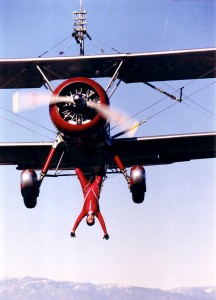
Although Margaret Stivers no longer performs this stunt, her “Gear Strut Hang” was an impressive feat. She was the first woman to perform the aerobatic maneuver since the 1920s.
Another type of art first drew Stivers into the wild world of wing walking. As a student studying architecture in Pasadena in the 1980s, Stivers had some interest in flight; she even took a few flying and soaring lessons. She intended to work in the architectural field, but when she was commissioned to do a pen and ink drawing of a Stearman biplane, her path changed.
“I was just so curious about the way this plane was made,” Stivers said. “The lines of the Stearman were beautiful to me. That was the hook that pulled me into learning to fly one. I wanted to know how the plane was made.”
To satisfy her curiosity, Stivers drove to Chino Airport (CNO) to seek out the owner of the Stearman Flight Center. She found the company’s founder, owner and sole employee at the time, a rugged aerobatic pilot named Hartley Folstad.
A legend among Stearman buffs, Folstad had restored the old biplanes for years between shifts of his day job as a captain for United Airlines. His career began in the U.S. military, where he flew carrier missions, piloted F9F-8 Cougars and taught aerodynamics at the Navy’s command school in Pensacola, Fla.
With more than 20,000 flight hours under his belt since his first solo in a Piper Cub in Missouri, Folstad also indulged his passion for aerobatics, flying an impressive 52-show season in 1989, with Disney’s Royal Flying Circus. He founded the Stearman Flight Center in 1982 to provide aerobatic instruction and occasionally gave hour-long rides to budding pilots like Stivers.
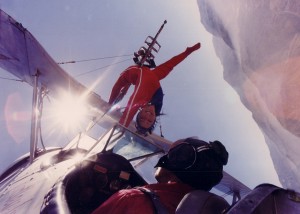
Margi Stivers greets her husband, pilot Hartley Folstad, and demonstrates her remarkable flexibility during a backbend.
“I went up, and I just loved it,” Stivers said, remembering their first flight together. “He let me loop and barrel roll the plane. I remember looking for the horizon over my head. He let me bring the plane down to about a foot above the runway, and then he finished the landing. It was a fantastic experience. I was floating for weeks afterward.”
Stivers finished her private pilot’s license and returned to the flight center to learn to fly the biplanes. When she gave Folstad a copy of the drawing that started their budding relationship, he managed to get her phone number. After a decade-long courtship, they were married in 2002.
“He’s very strong,” Stivers said of her flying partner. “He’s my knight in shining armor. He has a character that I look up to, in addition to being a good friend. We’re in synch, personality-wise. He’s absolutely incredible, and yet he talks very little about himself.”
Folstad remains mum, preferring to let Stivers do the talking for Silver Wings. His impressive flying history speaks volumes by itself. His elation in flying, and all the other fun things in life, shines through in his performances.
“He prefers to be likened to a lion, but I think of him as an otter,” Stivers laughed. “You know when an otter is really fishing, but it looks like playing all day? That’s Hartley. He has a joyful attitude about everything he does. He makes everything look like you want to join him, like Tom Sawyer.”
Becoming a wing walker
In 1990, Folstad founded the Silver Wings aerobatic troupe, which initially performed a dynamic formation aerobatic act with three to five Stearman biplanes flown by professionals like Jimmy New and Ron Caraway. The group was performing at the Empire Balloon and Wine Festival in Indio, Calif. when Margaret Stivers’ first wing-walking opportunity presented itself, much to her surprise.
Folstad had piloted a different wing-walking act in the past, so he had some experience. When a fellow stuntman asked Hartley to mount a specially designed rack on the plane for a performance, everyone in the group was eager to try it—except Stivers.
“I had no desire to wing walk at all,” she remembered. “I loved being a pilot. But this guy did the Saturday show and couldn’t do the Sunday show. So Hartley said, ‘Well, Margi, we’ve got some time. Why don’t you go wing walking this afternoon and do the performance Sunday morning?’ I trusted Hartley, so I said I would try it.”
Wearing a leather jacket, blue jeans and cowboy boots—not the ideal costume for perching on the wing of a moving plane—Stivers gave in.
“I knew in the back of my brain that if I didn’t do it, these guys were never going to let me forget it,” she said. “At the same time, my brain was screaming, ‘Stop, stop, stop. What are you doing?’ I’ll say it straight out: there was peer pressure. I climbed up, and at that point, I had no knowledge of the sensation of being outside a plane. I told myself that it was like climbing a mountain. Once you get to the top, you never have to do it again. I thought I had to try it, just once.”
Every great journey begins with a single step, but Stivers’ first step was a big leap of faith. With prop wash blasting her face and the roar of a 450-horsepower engine in her ears, she managed to exit the cockpit, fighting against every survival instinct in her body.
“I had to push through what I call ‘the wall of wind,'” she said. “But it’s also pushing through a wall of sanity. You have to break through this invisible barrier that is mentally holding you back and physically pushing you down.”
Climbing to the top wing and attaching a rudimentary seatbelt, Stivers finally had the opportunity—and the courage—to look down.
“Something amazing happened,” she said. “The minute I put the belt on, everything changed. It was like walking around on a gloomy day, and then the clouds part and the sun shines down, just on you. That’s what that first moment was like. It was a complete break with everything that had come before in my life. I started dancing up there. For the first time in my life, I was the person on the outside that I am inside. I was completely and totally fulfilled.”
She also had a new career as Folstad’s wing-walking partner and, she jokes, the most interesting hood ornament a vehicle ever carried.
“I became a wing walker in that instant,” she remembered. “I never looked back. It was like I was finally home.”
Evolution of flight
For 10 years, the Silver Wings team was primarily an aerobatic team, with Stivers wing walking on the lead plane flown by Folstad. As she learned more about the history of wing walking, she began to think about ways she could improve her own showmanship.
“In my second year, I started trying to figure out something unique I could do in the air, rather than just being ‘the bug on the windshield,'” she recalled. “It was a pretty closed society when I started doing these stunts. I asked another wing walker how to do a headstand and the only advice I got was, ‘It hurts your head.’ So I had to start figuring things out myself.”
On a cold, rainy January day, Stivers started working on a grounded Stearman, trying to figure out where she could safely place herself on the plane’s modest exterior. It didn’t come naturally for her.
“It took me 10 minutes just to get myself untangled and get down; it wasn’t pretty,” she laughed. “I was trying all these different things the way I had seen other people do them. But with my body type, it wasn’t happening. So I just had to get out there and learn what works for me.”
She had a body harness built and started practicing. Her organically developed act soon included a forearm stand, a modified version of the headstand, where Stivers rests on her arms with her legs curled up the rack behind her. She also figured out a way to completely let go of the plane, “flying” freely, with cables connecting her to the wing-walking rack.
“You get some pretty wild oscillations when you do that,” Stivers said. “I was basically using the whole plane as a parachute as I flew off. Now I tend to hold on to stabilize myself, but when Hartley gets the airspeed up, I can really fly.”
Eventually, she started figuring out the moves and now has dozens of maneuvers in her repertoire, stunts with colorful names like “the skysurf loop,” “the ballet barrel roll” and “the handstand hammerhead.”

In her unique interpretation of an aerial handstand, Margaret Stivers performs her forearm stand on top of the Stearman’s top wing.
Stivers is the first woman to hang below the gear axle since the stunt was first performed in the 1920s. She was encouraged by renowned stuntman Lee Oman and in 1995, started performing stunts hanging below the gear axle and end strut. She retired that part of the act in 2004 because of safety concerns.
“Lee retired and said he was handing the baton to me,” she remembered. “I went back to the 1930s where they hung from their knees. I’ve taken those stunts out of the routine, because if the engine coughs, we could come down before I knew there was a problem.”
In 2000, the other pilots in the Silver Wings team retired from aerobatic flying. It led to a new era for Stivers and Folstad, who hired themselves out as a solo act focused on wing walking.
“At that time, I was still mostly looping and rolling,” she remembered. “I didn’t feel like I was communicating with the audience, and part of me was pretty frustrated. When we changed the show, all of a sudden the joy came back. Hartley and I both felt it. I really felt like the crowd could see what I was doing and I could reach out to them again. I like the direction it’s going right now.”
Today, the couple’s show is a dazzling display of physical and aerobatic expertise. Dressed in a jazzy lycra costume, reminiscent of a costumed superhero, Stivers first climbs to the top wing, waving to the crowd and performing a can-can kick. With safety lines attached, she works through a carefully arranged series of maneuvers, including the forearm stand, a backbend over the cockpit, a splits maneuver in the wing area and the “victory pose,” poised on the rack with one leg in the air. The show culminates with Stivers raising an America flag and saluting the awestruck spectators during a slow final pass.
“I think all spectators are a little different in what they take away from a wing-walking act,” Stivers said. “Some people really enjoy the aerobatics of the person hanging upside down. When I see it, I identify with someone doing something really physically difficult—on an airplane, no less.”
Zen and the art of wing walking
So what’s it really like up there? Stivers answers that question after every show. She walks the crowd line following each performance and hands out cards with her picture, a cherished token for delighted fans. Her answer may be more poetic than the actual experience.
“The wind is an invisible dancing partner, pushing against you,” she said. “When someone pushes against you, you push back. That’s what it’s like to be on the wing, pushing against this invisible source and working with it, not against it. There has to be a trust in the wind—and if there’s turbulence, sometimes it drops you. You’re also working with the pilot and the plane. At certain points, when we’re doing dives, I can’t breathe. It’s like being pulled underwater for a few seconds and then pulled back up.”
Although Stivers is very honest with eager fans, sometimes it’s difficult to explain the complexities and challenges of her job.
“They see me do it and think, ‘What a lot of fun,'” Stivers said. “One girl thought it would be peaceful and quiet up there. I hate to laugh at that, but I just thought, ‘Oh, dear.’ You’re sitting up there with a noisy Pratt & Whitney engine in your ears and your face is blown to bits. It’s not anything like a roller coaster thrill ride, either. I suggested she try soaring.”
Safety is of paramount concern to both pilot and wing walker. Each performance may look impromptu to untrained observers, but it’s really a carefully rehearsed, very specific series of movements. At all times, Stivers is connected to the aircraft with at least one, and sometimes multiple, steel safety cables.
“People like to see what they think is a certain bit of danger,” Stivers admitted. “But I have to be able to problem solve and troubleshoot my way during a performance. I have to learn to work in places on the plane where I’ll be safe if the engine quits.”
While aerobatic pilots must apply for an FAA waiver from their local Flight Standards District Office that allows them to perform their complex aerial maneuvers, no regulations govern wing walkers, nor does Stivers believe any should.
“I hope it never gets to that stage, because each of us is very different in the way we do things,” she said. “What works for one person doesn’t work for another. We’re artists and each of us has a unique style. Every artist has a palette and a brush, but everyone applies the paint differently. You can’t apply paint-by-numbers rules to our work.”
Weather plays a role in determining which acts are in the show; Stivers prefers not to perform on a slippery wing and flag-raising is out of the question with soggy ropes. Power management is another essential factor in the act. At lower speeds, Stivers is capable of moving comfortably throughout the plane, but during accelerated ascents and descents, movement can be virtually impossible.
“I personally believe a wing walker should also be a pilot, because you have to be in sync with the pilot and understand why he’s doing what he’s doing,” Stivers said. “I’ve flown almost exclusively with Hartley, so we know our routine. It’s a dance with a partner you know very well. Communication is done mostly by looks. I can tell whether or not to move by glancing at his demeanor. I can’t move to a different place on the plane until he pulls the power back. It’s a big safety issue. I have to depend on him and wait for his signal.”
The couple occasionally performs unique routines for air-to-air photography, video or commercial work. In fact, it was a Silver Wings Stearman that their friend, stunt pilot Craig Ockers, flew during the dramatic barnstorming scene that opens the movie “Space Cowboys.” Their work has also been seen in the film “The Barnstormers,” in various commercials and on television shows like “Wings,” “Hollywood Stunts” and “Fear Factor.” Stivers performed more than 40 wing walks last year alone, outside of the air show circuit.
Their hearts, however, remain with the enthusiastic air show crowds. While she’s paying attention to her pilot, Stivers is also watching the crowd during her performances.
“I need to see the crowd to know where to perform,” Stivers said. “It’s easy to get disoriented, especially if you’re upside down. I usually pick a big object in the crowd center and focus on it. The stunts begin with a vision and over the years they get modified, based on what I think is good for a crowd.”
It may seem like Stivers and Hartley are aerial daredevils like the barnstormers before them, but the reality is that wing walking is a full-time job that requires intense preparation. Stivers performs ballet and practices Pilates several times a week and intensifies her core exercises and practice sessions during the summer air show season. They begin wing-walking practices in January and don’t stop until late November.
“It’s a discipline, meaning I practice and work hard,” Stivers said. “It’s like a competitive sport. I study the cycles that athletes go through when they’re preparing for competitions. It’s not something we ad-lib. A lot of kids ask me if I’m scared. I ask them, ‘Are you scared when you take a test?’ No, because it’s just another challenge, and if you’re prepared for it, it will be OK.”
But last year, a physical challenge came up that Stivers didn’t anticipate. She overcame it with gusto.
Return to flight
In August 2006, Stivers began experiencing some discomfort in one knee but didn’t think it was anything serious. After all, she was used to a few aches and pains from her physically demanding work on top of a flying Stearman. But six weeks later, she was doing a move in ballet class and tore the cartilage in her knee.
“I wasn’t sure what was wrong,” she recalled. “I even did a show with it. But I woke up the next morning and realized something wasn’t right. I wasn’t going to take a chance with my body by wing walking. I’m not going to do something stupid at a show because I haven’t bothered to take care of myself.”
Stivers saw a knee specialist in Beverly Hills, Calif., who scheduled her for arthroscopic surgery less than a week later, on Oct. 4. The surgery was successful, but it would take time for her to recover. In the meantime, Silver Wings had a handful of important appearances left in their year, including the Marine Corps Air Station Miramar Air Show and the Edwards Air Force Base Air Show.
“The air shows were wonderful to me,” Stivers said. “I had to call them up and say, ‘There’s a glitch. Actually, I’m the glitch.’ But I solved the problem for them.”
Stivers made a quick call to Jenny Forsythe of Bob Essell Air Shows, a good friend and one of the most skilled wing walkers in the business. She immediately agreed to fill in, flying with Folstad at the shows. To make her own contribution, Stivers agreed to do the announcing during their performances, adding her own unique perspective on her substitute’s fine performances.
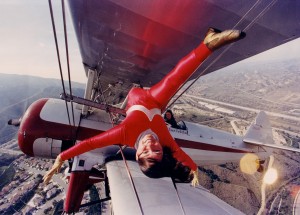
In a maneuver performed only for air-to-air photography, Margi Stivers does “the splits” in the middle of the Stearman’s wings, while pilot and husband Hartley Folstad looks on.
“Jenny had flown with Hartley and had studied my stunts,” Stivers said. “She merged them into her own variations. I knew she could capture the flavor of my shows, and she was terrific. I think I was more emotional than Jenny. I was so proud of the work that she did and the performance they gave those crowds. It was also a really good learning experience, because it was the first time I got to see my act from the ground.”
After a few months of rest and recuperation, Stivers was ready to take wing again. On Jan. 1, 2007, she climbed back on board the Stearman for the first time since her surgery. The flight wasn’t just to get “back in the saddle.” It was also Stivers’ one-thousandth wing walk.
“It was like learning to wing walk all over again,” Stivers said. “It was a little more humbling than I thought it would be. I always told people that wing walking was like learning to climb stairs. Then I had to learn it all over again. Now I know that climbing stairs is hard!”
Stivers is now back to 100 percent and right in the middle of a busy air show season, delighting spectators across America. Folstad and Stivers are also trying to educate people about their trade, with the formation of the American Wingwalking Alliance, founded with other professional teams, including Bob Essell Airshows and American Barnstormer. The organization allows members to share information and advertising expenses and preserve wing-walking history.
“We’re trying to open up doors between wing walkers,” Stivers said. “There’s a common thread in our shows, which is providing family-friendly and educational entertainment that has historical roots. It’s our common denominator. The alliance also comes from teams that have established themselves and have the experience and the vocabulary to talk about our work. It helps promote wing walking in a very positive light.”
Silver Wings is an inspiration, not only to other wing-walking teams, but also to those who experience the thrill of seeing Folstad and Stivers soar across the sky. During every flight, the team lives up to its motto: “Dreams are accomplished one step at a time.”
“What people take away is the experience of seeing someone doing something unusual, something that they love,” Stivers said. “A lot of young adults get it. They may not want to be wing walkers, but maybe they have something inside them that they want to do, but people aren’t listening to them. If they can see what I’ve done, maybe they can find the courage to try something new. They might just be able to pursue their own dreams, and make them come true.”
For more information about the Silver Wings Wingwalking Team, visit [http://www.silverwingswingwalking.com]. To learn about the American Wingwalking Alliance, visit [http://www.americanwingwalkingalliance.com].
- Margaret Stivers and Hartley Folstad have been married since 2002. Their partnership extends to their impressive routine as the Silver Wings Wingwalking Team.
- Margaret Stivers resembles a flying superhero in her dynamic costume, flying alongside the Stearman biplane flown by her husband Hartley Folstad.
- Margaret Stivers has several different outfits, including this glitzy number, to suit any wing-walking occasion.
- Margaret Stivers and Hartley Folstad are consummate performers, dazzling air show audiences with his aerobatic maneuvers and her artistic physical finesse.











